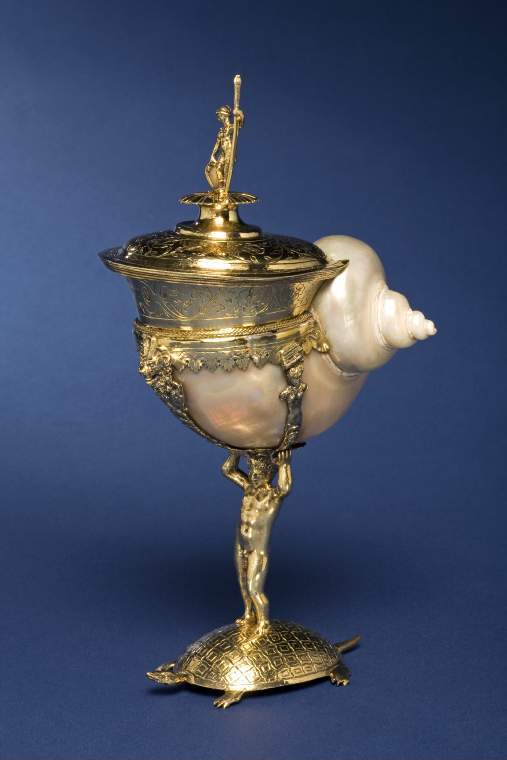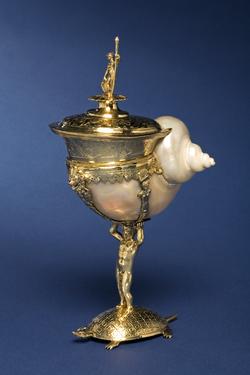Current Location: Gallery 12 (Adeane)
Titles
Turbo Shell Cup
Maker(s)
Silversmith:
Vianen, Ernst Jansz. van
(Probably)
Silversmith:
Verhaer, Albert
(Perhaps)
Entities
Categories
Description
Silver gilt; turbo shell mounted in silver-gilt, the stem and foot in the form of a putto standing on a tortoise; the fitted cover surmounted by the figure of a warrior
Silver-gilt; the rim of the turbo shell is mounted with a deep silver-gilt border, which is engraved with scrolling flowers and foliage. Beneath this is a rope border over an engraved border of tongues. The central strap is formed as a pair of entwined snakes with a lion's mask capital. The two side straps are formed as hermes. The shell is supported on a stem modelled as a putto standing on a turtle. The stepped cover has an engraved border of scrolling flowers and foliage. In the centre, on a raised gadrooned boss, stands the finial modelled as a warrior.
Notes
History note: Not known before testator
Legal notes
C.B. Marlay Bequest
Measurements and weight
Width: 11 cm
Width: 4¼ in
Acquisition and important dates
Method of acquisition: Bequeathed
(1912-06-18)
by
Marlay, Charles Brinsley
Dating
17th Century, Early
Production date:
possibly
AD 1628
Note
Label text from the exhibition ‘Feast and Fast: The Art of Food in Europe, 1500–1800’, on display at The Fitzwilliam Museum from 26 November 2019 until 31 August 2020:Turbo shell standing cup and cover with a boy standing on a turtle Turbo shells come from large sea snails living in warm tropical waters, often near coral, and were in great demand by European collectors. They were individually harvested – like pearls – by divers who risked their lives in deep waters, and then sold, by merchants, to specialised shell shops in the Dutch Republic. In this virtuoso example, the polished shell has been skilfully converted into a drinking vessel by mounting it on a stem and foot, curiously formed as a naked boy standing on a turtle. It has a tightly fitting, lift-off cover to prevent poison from being introduced and unwanted matter from falling inside. The protective purpose of the cover is reinforced by the fact that it is crowned by a standing warrior. Its lack of wear suggests that it was primarily kept for display.
The mark of three lozenges is most commonly attributed to Ernst van Vianen recorded in Utrecht 1602-40 but is also associated with Albert Verhaer, recorded in Utrecht in 1590 and in Haarlem 1593-1607. Two tazze (both dated 1602) with the same maker's mark as this cup, can be found in the collections of the Victoria and Albert Museum (no. 393-1583) and the Rijksmuseum (no. BK-1960-14).
School or Style
Mannerist
People, subjects and objects depicted
Components of the work
Shell
composed of
turbo shell
Surface Of Mounts
composed of
gold
Mounts
composed of
silver
To Top Of Finial
Height 20 cm
Height 7⅞ in
Gross
Weight 285 g
Weight 9:3 oz:dwt
Cover
Decoration
Stem
Inscription or legends present
Inscription present: a shield within a double circle
- Location: On the front of the rim amongst the engraved decoration
- Method of creation: Struck
- Type: Town mark
Inscription present: three lozenges within a shield
- Location: On the front of the rim amongst the engraved decoration
- Method of creation: Struck
- Type: Maker's mark
- Text: L
- Location: On the front of the rim amongst the engraved decoration
- Method of creation: Struck
- Type: Date letter
References and bibliographic entries
Related exhibitions
Identification numbers
Accession number: MAR.M.71 & A-1912
Primary reference Number: 160127
Stable URI
Audit data
Created: Saturday 6 August 2011
Updated: Friday 1 August 2025
Last processed: Thursday 14 August 2025
Associated departments & institutions
Owner or interested party:
The Fitzwilliam Museum
Associated department:
Applied Arts

 IIIF Manifest
IIIF Manifest




